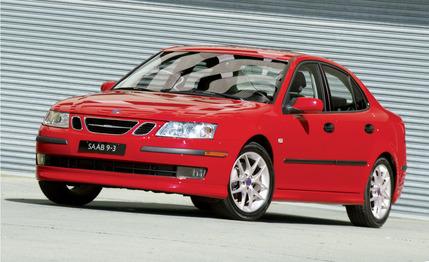
 Road Test
Road Test
Saab's all-new 9-3 sports sedan did not bounce the BMW 3-series off our 10Best list this year. No surprise there, you say? Well, maybe not, but it wasn't as far back in the voting as you might have expected.
It is our policy not to reveal the 10Best finishing order, but we can say that the 9-3 was the first Saab in recent years to gain so high a measure of respect around here.
It probably helped that our test car was the sportiest of the 9-3 line, the $33,120 Vector. As we reported last September, the new 9-3 comes in three editions, the Linear ($26,525), the Arc ($30,620), and the Vector. None is available anymore as the practical and favored hatchback. For now the four-door sedan is the only body offered. The convertible switches to the new architecture later this year, and wagon variants are expected to follow.
Saab designers have their reasons for dissing the hatch. Although many of us thought the hatchback gave the 9-3 a practical edge, Saab says a majority of folks with 30 grand to spend on their cars think hatchbacks look cheap. And when the 9-5 went sedan only, it added nearly half again the volume of the hatchback-available 9000 model it replaced in 1998.
Could it be that a Saab with a trunk can compete with the BMW 3-series and Audi A4, cars Saab acknowledges as major rivals? The exterior styling plays along. With a chunky but smooth profile, short overhangs, and a high trunklid, Saab says the new shape has a slippery 0.28 coefficient of drag (Cd). Honda's wind-cheating Insight has a 0.25 Cd. Clearly, Saab sweated the details with this exterior, which is somehow both aggressive and subtle. The tires, for example, nicely fill the wheel wells, and there are few extraneous trim pieces.
If only the interior designers were as inspired. Inside, there's a prominent center console that's awash with Chiclets-size buttons - 39 in all - that are nearly impossible to discern at a glance.
In addition, there's an eight-inch-long fixed, elliptical LCD screen, called the Saab Information Display, that is centrally mounted where the top of the dash meets the base of the windshield. It displays the trip-computer information as well as the outside temperature, the radio station, and if equipped, navigation instructions. There's also a screen two inches by three that's on the vertical face of the center console that shows radio and phone data (if so equipped). This two-screen arrangement creates confusion because we never seemed to choose the right place to find the information we wanted.
We found the radio knobs to be likewise confusing. The radio layout looks correct, with a dial on each side of the radio's face. The left knob controls volume and power - same old, same old - but the right one, the tuning knob in most cars, is used to select what information - radio station, preset list, whatever - is displayed on that small screen and to choose several radio options. For example, switching from FM to AM means using the knob to rotate through a serious of menus, choosing the audio menu first, then the band menu, and finally, you can select AM.
Anything good inside? Well, the hand-brake lever is neatly integrated into the center console, the dual-zone HVAC system worked flawlessly, and the front sport seats (standard on the Vector model) are fantastic. They have substantial side bolstering but don't feel constricting. And in this car, the rich aroma of leather (standard on the Vector model) is in the air.